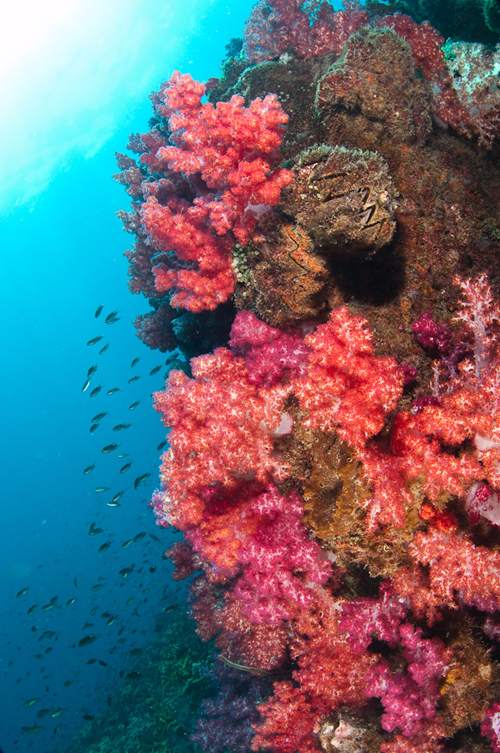Metering
Exposure Metering For Underwater Photography
Your camera has a built in light meter, which takes a reading of the light in any given scene and can calculate the best exposure settings based on this reading. This is called exposure metering. If shooting in manual mode, you will adjust your settings based on the display of the meter reading in your viewfinder or LCD screen, and in auto modes the camera will automatically adjust the settings accordingly.
Cameras generally have three different types of metering modes that effect how the camera reads the light and chooses the exposure settings. The different modes take readings from different parts of the scene. The modes are: Matrix metering, center weighted metering and spot metering. Different situations call for different metering methods, so understanding how each works is an important step towards achieving correct exposures.
Matrix or Evaluative Metering
Matrix metering uses very sophisticated and complex algorithms in your camera firmware that tries to predict the scene you are shooting and the correct exposure for that scene. The camera splits the scene up into a matrix and then takes a light reading on each individual segment. The exposure is based on different variables across the scene. The precise method varies by manufacturer and the algorithms are kept secret.
This works very well for your average topside scene, where there isn't an extreme dynamic range of brightness levels. Underwater, however, you lose light with depth so often the brightness gradient is extreme, with bright light blues towards the surface, to dark deep blues at greater depths. This is especially true when shooting verticals. Even the most advanced algorithms have trouble properly reading the extreme lights and darks of a typical wide angle underwater scene. When shooting into the sun, the area near the surface is so bright that most of the image is underexposed because the camera tries to ensure that the extreme bright area is not overexposed. If you are shooting an already bright subject, the image tends to be overexposed because the camera will overcompensate for the darks at the bottom of the image. This makes matrix metering not the best option for many wide-angle underwater scenes.

For macro images that don’t contain much open water, it does not matter what kind of metering mode you use because the primary source of light is from your strobe. When you use your camera’s light meter, it gives a reading that is based on the ambient light, which is usually not used in most macro images, except creative approaches when it is purposely included.

If you do find yourself in an underwater scene that has relatively balanced tones, you can experiment with matrix metering. This mode can also be especially useful if you are shooting an animal that is moving quickly, such as a whale shark, and the correct exposure is changing rapidly. The other forms of metering require you to selectively choose the area you want correctly exposed, which is always changing when shooting a moving subject.
Center Weighted or Average Metering
This is usually the “default mode” and the mode that is utilized by cameras that don’t provide an option in metering methods. Essentially, with center weighted metering, the camera takes an average reading of the entire scene, but places a heavy emphasis, between 60 and 80 percent, on the center of the frame.
This is usually a much better option than matrix metering for a typical underwater wide angle scene because you can indicate to the camera the area that you would like correctly exposed, while it still takes the brightness levels of the rest of the scene into account. This can help counteract the camera’s inclination to over expose a scene with a bright spot such as a sun, or underexpose a scene with dark areas like the bottom of reefs or fall-off into the blue.
Center weighted metering takes more effort than matrix metering because you have to select an area that you want to be exposed properly. If you meter on a scene so that the center is the white bottom of a shark, or the bright sun, you will incorrectly expose the rest of the image. However, if you select a mid-range blue from the water column, you should be able to produce a nicely exposed image.
When shooting a wide angle subject with strobes, remember that you goal is to balance the ambient exposure of the background, with proper lighting of your subject by your strobes in the foreground. When metering on open water indicates a proper exposure level, your subject should meter as underexposed, which will be compensated for with your strobes to create a well balanced image.

Spot metering
Spot metering gives you the greatest control over your exposure reading. Essentially the entire reading is based on a very small part of the scene. Most of the time it’s the center of the frame, although some cameras allow you to choose the “spot” based on the position of the focus bracket. This gives you even more precise control over the exposure, but also requires a careful assessment on the best place to meter. This can be extremely useful in scenes with high contrast, where the area you correctly expose is extremely important. For example, if you are shooting a silhouette, you want to purposely underexpose the subject while not turning the sun into a blob of white, so where you meter is of the utmost importance. Spot metering is perfect for this kind of selective exposure.
Explore
Try different metering modes on your next dive you are shooting wide angle and see what the results are. Remember, though, that your cameras light meter was designed for air, not the depths of the ocean and readings are just a good starting place. The camera is only making recommendation based on the light, but the final decision is yours.
Featured Photographer

 Antarctica
Antarctica




